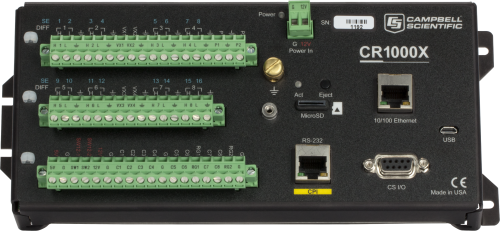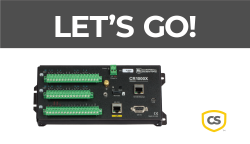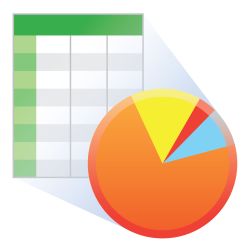This product is not available for new orders. We recommend ordering: CR1000Xe.

| Services Available | |
|---|---|
| Repair | Yes |
| Calibration | Yes |
Overview
The CR1000X is our flagship data logger that provides measurement and control for a wide variety of applications. Its reliability and ruggedness make it an excellent choice for remote environmental applications, including weather stations, mesonet systems, wind profiling, air quality monitoring, hydrological systems, water quality monitoring, and hydrometeorological stations.
The CR1000X is a low-powered device that measures sensors, drives direct communication and telecommunications, analyzes data, controls external devices, and stores data and programs in onboard, nonvolatile storage. The electronics are RF-shielded by a unique sealed, stainless-steel canister. A battery-backed clock assures accurate timekeeping. The onboard, BASIC-like programming language, common to all contemporary Campbell Scientific data loggers, supports data processing and analysis routines.
Read MoreBenefits and Features
- Operational in extreme environments with a standard operating range of -40° to +70°C and an extended operating range of -55° to +85°C
- Connects directly to a computer's USB port
- Captures quickly changing data values with fast analog measurement capabilities (300+ Hz)
- Differentiates even slight changes in data values with higher-resolution measurements (24 bit Adc)
- Includes two non-isolated current input channels for directly connecting sensors with 0-to-20 mA or 4-to-20 mA current outputs
- Contains an onboard CPI port for hosting Campbell high-speed sensors and distributed modules (CDM)
- Directly connects to Ethernet
- Includes microSD card drive for extended memory requirements
- Provides simple serial sensor integration and measurement with SDI-12, RS-232, and/or RS-485
- Supports full PakBus networking
- Includes embedded web page for direct connection via web browser
Images
















CAD Files:
Detailed Description
The CR1000X is a low-powered device designed to measure sensors, drive direct communication and telecommunications, analyze data, control external devices, and store data and programs in on-board, non-volatile storage. The electronics are RF-shielded and glitch-protected by a unique sealed, stainless-steel canister. A battery-backed clock assures accurate timekeeping. The on-board, BASIC-like programming language—common to all Campbell Scientific data loggers—supports data processing and analysis routines.
The CR1000X wiring panel includes two switchable 12 V terminals, analog grounds dispersed among 16 analog terminals, and unpluggable terminal blocks for quick deployment.
Compatibility
Note: The following shows notable compatibility information. It is not a comprehensive list of all compatible or incompatible products.
Measurement and Control
| Product | Compatible | Note |
|---|---|---|
| SDM-SIO2R |
Software
| Product | Compatible | Note |
|---|---|---|
| DevConfig | Version 2.16 or higher | |
| KonectGDS | ||
| LoggerLink | Version 1.6 or higher | |
| LoggerNet | Version 4.5 or higher | |
| LoggerNet Linux | Version 4.5 or higher | |
| PC200W (retired) | Version 4.5 or higher | |
| PC400 | Version 4.5 or higher | |
| RTDAQ | Version 1.3 or higher | |
| Short Cut | Version 4.0 or higher |
Additional Compatibility Information
Sensors
With several terminal types, the CR1000X is compatible with nearly every available sensor, including analog (both voltage and current), thermocouples, serial, SDI-12, pulse, and frequency sensors.
Measurement & Control Peripherals
The CR1000X is compatible with all our CDMs, multiplexers, vibrating-wire interfaces, terminal input modules, and relays.
Communications
The CR1000X communicates with a PC via direct USB port, 10/100baseT Ethernet port, multidrop modems, short-haul modems, phone modems (land line, digital cellular, and voice-synthesized), RF telemetry, and satellite transmitters (HDR GOES, Argos, Meteosat, Iridium, and Inmarsat).
Data can be viewed on the CR1000KD Keyboard Display, the CD100 Mountable Display with Keyboard, an iOS or Android device (requires our free LoggerLink app), CD295 DataView II Display, or other third-party devices.
Enclosures
The CR1000X and its power supply can be housed in any of our standard enclosures.
Power
Any external 12 Vdc source can power the CR1000X datalogger. Campbell Scientific power supplies commonly used with the CR1000X are the BPALK, PS150, and PS200.
Software
Campbell Scientific proprietary software is required to program, configure, and communicate with the CR1000X datalogger. Various software options are available to meet a breadth of application needs. At a minimum, Short Cut and PC200W are needed. Consult with a Campbell Scientific Support and Implementation Engineer to determine the best software option.
Specifications
| -NOTE- | Additional specifications are listed in the CR1000X Specifications Sheet. |
| Operating Temperature Range |
|
| Maximum Scan Rate | 1000 Hz |
| Case Material | Anodized aluminum |
| Analog Inputs | 16 single-ended or 8 differential (individually configured). Two analog inputs can measure 4 to 20 mA or 0 to 20 mA natively. Four analog inputs can provide pulse/digital I/O functions. |
| Pulse Counters | 10 (P1 to P2 and C1 to C8) |
| Voltage Excitation Terminals | 4 (VX1 to VX4) |
| Maximum Source/Sink Current |
|
| Communications Ports |
|
| Data Storage Ports | microSD |
| Switched 12 Volt | 2 terminals |
| Digital I/O | 8 terminals (C1 to C8) configurable for digital input and output. Includes status high/low, pulse width modulation, external interrupt, edge timing, switch closure pulse counting, high-frequency pulse counting, UART, RS-232, RS-485, SDM, SDI-12, I2C, and SPI function. Terminals are configurable in pairs for 5 V or 3.3 V logic for some functions. |
| Input Limits | ±5 V |
| Analog Voltage Accuracy |
|
| ADC | 24-bit |
| Power Requirements | 10 to 18 Vdc input (See manual for further details.) |
| Real-Time Clock Accuracy | ±3 min. per year (Optional GPS correction to ±10 µs) |
| Internet Protocols | Ethernet, PPP, RNDIS, ICMP/Ping, Auto-IP (APIPA), IPv4, IPv6, UDP, TCP, TLS (v1.2), DNS, DHCP, SLAAC, Telnet, HTTP(S), SFTP, FTP(S), POP3/TLS, NTP, SMTP/TLS, SNMPv3, CS I/O IP, MQTT |
| Communications Protocols | CPI, PakBus, SDM, SDI-12, Modbus, TCP, DNP3, UDP, NTCIP, NMEA 0183, I2C, SPI, and others |
| Battery-backed SRAM for CPU Usage & Final Storage | 4 MB |
| Data Storage | 4 MB SRAM + 72 MB flash (Storage expansion of up to 16 GB with removable microSD flash memory card.) |
| Idle Current Drain, Average | < 1 mA (@ 12 Vdc) |
| Active Current Drain, Average |
|
| Dimensions |
23.8 x 10.1 x 6.2 cm (9.4 x 4.0 x 2.4 in.) Additional clearance required for cables and leads. |
| Weight | 0.86 kg (1.9 lb) |
Documents
Manuals
Technical Papers
Compliance
Miscellaneous
Videos & Tutorials
Downloads
CR1000X(e) OS v.8.2.1 (6.71 MB) 04-07-2025
This download is for the CR1000X and CR1000Xe dataloggers. Execution of this download places the Operating System file(.obj) on your computer. It also updates the CRBasic Editor compiler and support files.
Why Update? New features and bug fixes. With this OS update it is recommended that you also update the Device Configuration Utility to the most recent version so that new datalogger features are available in the utility.
Note/Warning: Campbell Scientific always recommends updating operating systems on site if possible. When remote updates are required, it is recommended that you implement the necessary precautions to handle unexpected OS upload complications. All datalogger settings should be retained when updated remotely. If you choose to roll back to a previous operating system, the datalogger settings will be reset to default.
Watch the Video Tutorial: Sending an OS to a Local Datalogger.
CR1000X Web Browser Interface v.1.2 (970 KB) 09-13-2024
Standard Datalogger Web Browser Interface
Use this download to update the data logger's web browser interface.
To install this file, send it to the data logger using file control found in the Device Configuration Utility or file control found in LoggerNet.
This interface is recommended for fast IP interfaces like Ethernet and Wi-Fi. It does NOT perform well over slow communications mediums like cellular.
Note: This is NOT for system data loggers that have custom interfaces like the SunSentry, Hydro-Link, Alert205, and MeteoPV.
CPI Calculator v.1.0 (2.49 MB) 07-06-2016
The CPI Calculator is a downloadable Microsoft Excel spreadsheet used to estimate the usage and capacity of a CPI network. The calculator provides an overview on CPI devices including the CDM-A108, CDM-A116, CDM-VW300, CDM-VW305, and the CSAT3B. The calculator can also estimate the measurement speed of the CDM-A108 and CDM-A116 based on the number of channels and measurement parameters.
The CPI Calculator is an estimation tool and will help you better understand and design CPI networks by considering the following:
- What is the capability of each CDM or CPI device
- What is the CPI network capacity
- How much of the CPI capacity are the CDMs or CPI devices using
Custom Menu Example Program for Connections Video v.1 (1 KB) 03-26-2024
This program demonstrates creating a custom menu for data logger displays and corresponds to the Campbell Connections video: Creating Custom Menus in CRBasic for a Data Logger Display.
Data Logger Wiring Excel Template (1 KB) 03-26-2024
This is a data logger wiring diagram spreadsheet template that accompanies the Wiring Diagram Video. The spreadsheet includes templates for CR6, CR1000X, CR300, CR310, and CR350 data loggers. The file is an Excel template and works best with Microsoft Excel.
Frequently Asked Questions
Number of FAQs related to CR1000X: 8
Expand AllCollapse All
-
Return the CR1000X to Campbell Scientific for repair. For assistance obtaining a Return Material Authorization (RMA), follow the instructions on the Repair and Calibration page.
-
When idle, the CR1000, CR6, and CR1000X consume less than 1 mA @ 12Vdc. Similar to the CR6, the CR1000X has a much faster processor that requires more power when up and running. As such, there will be higher current draws during active measurements, serial communications, or when plugged into a PC via USB or Ethernet.
It may be helpful to think of the CR6 and CR1000X as being built on the same "platform."
-
The CR1000 and CR1000X will be sold concurrently for no less than two years. We anticipate the CR1000 will be retired in December of 2019 and will be supported until December of 2029.
-
If a CPI-enabled device is running and there are skipped scans in the data logger, what can be done?
The default CPI bus speed setting is 250 kB/s. The speed is adjustable in your CRBasic data logger program. Use the CPISpeed() instruction in your CRBasic program to adjust the CPI bus bandwidth to meet the following maximum combined (total) Ethernet cable lengths:
- 1000 kB/s for maximum combined Ethernet cable lengths of 15.2 m (50.0 ft)
- 500 kB/s for maximum combined Ethernet cable lengths of 61.0 m (200.0 ft)
- 250 kB/s for maximum combined Ethernet cable lengths of 152.4 m (500.0 ft)
-
The potential transformer and the current transformer provide differential outputs that have galvanic isolation from the voltage and current in the circuit they are measuring. However, there is no need to run the outputs of these transformers into differential inputs of the data logger and unnecessarily consume additional data logger channels. We conducted extensive testing for noise immunity, for inaccuracies from ground loops, and more before concluding that single-ended measurements in the ACPower() instruction have the same performance as differential measurements would provide. Please note that as a result of the galvanic isolation of the potential transformer and current transformer, the data logger ground is NOT connected to the ground of the circuit they are measuring.
Said differently, you can connect differential outputs of a sensor to single-ended inputs of the data logger. However, doing so creates the possibility of poor common-mode noise rejection in the data logger and the possibility of introducing inaccuracies from ground loops between the sensor and the data logger. Note that in this application, the transformer isolation of the potential transformer and the current transformer eliminates these concerns.
Simply connect one of the potential transformer secondary wires and one of the current transformer secondary wires to the data logger ground. Which wire in either case makes a difference, as the phase information allows the measurement of power flowing in either direction. If you measure negative real power when it should be positive, then reverse the secondary wires of the potential transformer where they connect to the data logger. Alternatively, you can reverse the secondary wires on the current transformer, but don't reverse both pairs of wires.
-
Although there are significant additions to the CR1000X program instructions that are not available in the CR1000, in most cases, you can load your program written for the CR1000 to a CR1000X with minor instruction changes. The most notable of the minor instruction changes is in the analog measurement instructions. For more information, see the "Replacing Your CR1000 Data Logger with a CR1000X: What You Should Know" blog article.
Case Studies
In 2022, as Hurricane Fiona unleashed relentless rain on Puerto Rico, the Puerto Rico Landslide......read more
Background Manitouwadge Municipal Airport is located 48 km (29.8 mi) north of highway 17 on Highway......read more
The Homestake Neutrino Experiment—also referred to as the “Davis Experiment” after physicist Ray Davis, who......read more
Overview In the fight against climate change, innovative solutions are emerging to address the global challenge......read more
Background In 2022, ECR Medio Ambiente assumed the responsibility of overseeing the structural monitoring installation at......read more
Overview In May 2019, the Government of Zambia embarked on the Climate Adaptation Water and Energy......read more
Overview The Royal Chapel of Chaalis Abbey—often referred to as the “French Sistine Chapel”—is a treasure......read more
Introduction At Campbell Scientific, we are committed to providing cutting-edge weather station solutions to organizations around......read more
Articles and Press Releases
Blog Articles
-
Putting People First: Crafting Cost-Effective Solutions with Campbell Scientific

05-07-2024 Author: Michael Adams -
A Deeper Look: Our Role in the Hole

04-23-2024 Author: Michael Adams -
How to Generate SFTP Keys Easily

09-12-2022 Author: Nathanael Wright -
But It’s a Dry Heat… like a Furnace

06-21-2021 Author: Dirk Baker -
What You Should Know: Improvements to SMSSend()

04-09-2021 Author: Dana Worley -
It’s Time to Embrace the Hybrid

12-02-2019 Author: Kevin Rhodes -
How to Monitor Your Campbell Cellular Modem Data Usage: Part 1

01-16-2019 Author: Nathanael Wright -
New Product Support: Kipp & Zonen’s RaZON+

01-17-2018 Author: Matt Perry -
Get Answers to Your Data Logger Questions Quickly

01-04-2018 Author: Michelle Welch -
Integrated Peripherals: Expansion made easy

11-29-2017 Author: Timothy Jeppsen -
Replacing Your CR1000 Datalogger with a CR1000X: What You Should Know

10-11-2017 Author: Timothy Jeppsen -
New Ethernet over USB Functionality for Data Loggers

08-30-2017 Author: Dana Worley -
A Quick Comparison of the CR1000X, CR1000, and CR6 Dataloggers

08-16-2017 Author: Timothy Jeppsen -
The CR1000X: A New Generation of Data Loggers with Proven Functionality

08-02-2017 Author: Timothy Jeppsen
Newsletter Articles
Press Releases
Privacy Policy Update
We've updated our privacy policy. Learn More
Cookie Consent
Update your cookie preferences. Update Cookie Preferences
















































































